
Flags
of the American Civil War period are
among the most sought after of all
American flags. Prior to the
Civil War, Americans rarely
displayed the flag for personal use.
Consequently, flags with star counts
of 33 or fewer are very scarce.
The events of the Civil War,
starting even prior to the
commencement of the war with the
introduction of Kansas into the
Union as the 34th state and the
election of President Abraham
Lincoln in 1861, marked a turning
point in both the surge of
patriotism and the production and
display of the American flag.
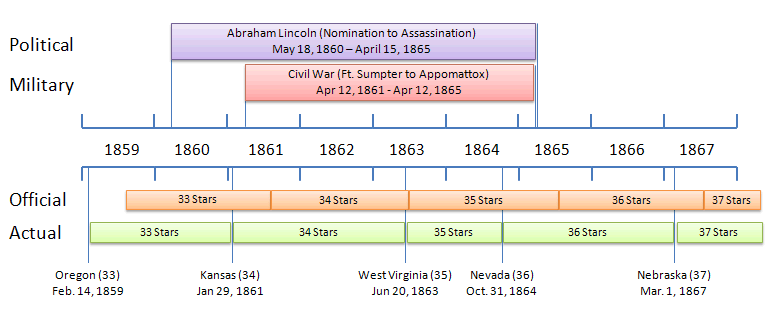
Civil War Star Counts
Traditionally, Americans begin
producing flags of a given star
count as soon as the new state
enters the Union. Officially,
though, the star count on flags is
adopted on the 4th of July, based on
how many states are in the Union on
the 4th. This leads to some
debate as to what constitutes a
"Civil War" flag. As a
collector, I personally consider
Civil War Era flags to be those of
33, 34, 35 and 36 stars. Of
the four counts, the only one that falls
unambiguously into the Civil War
military period is 35 stars.
Thirty-three star flags were
official during the start of the
Civil War, but 34 stars were
predominantly produced because of
the introduction of Kansas ten weeks
prior to the outset of open
hostilities at Fort Sumter.
Typically, 33 star flags are
associated with the election of
Abraham Lincoln, a star count found
on many political parade flags of
the era relating to the
Lincoln-Hamlin ticket in the 1860
Election. Although
Nevada became the 36th state nearly
6 months prior to the surrender at
Appomattox, the star count did not
become official until July 4, 1865,
nearly 3 months after surrender.
Therefore, while 36 star flags were
certainly produced during the war,
it's not possible, unless a flag is
positively dated in writing or
documentation, to place its creation
during the military period of the
war. Still, flags of 36 stars
also represent the beginning of
reconstruction and national healing
that immediately followed the end of
the war.
|
Types of Civil War Flags
All
types of flags were produced during
the Civil War Era. Several
categories of flags stand out among
those of the era:
Printed parade flags with overprints
of the electoral candidates of
Abraham Lincoln's two elections--1860
and 1864--are very rare and highly
sought after. Rare examples
with various Lincoln portraits in
the canton are among the most
valuable of all printed parade flags
of any era.
Military battle flags, from either
Union or Confederate units, are
extremely scarce. Union colors
in private hands are extremely rare,
since most units turned their battle
colors into their state armories and
capitals following the war as the
units were deactivated.
Confederate colors were often taken
home following the war, and though
they are somewhat more prevalent in
private hands, they tend to command
even higher prices than Union colors
in the open market.
Private sewn flags and parade flags
flourished during the Civil War era.
Flags were hung on government
buildings, at recruitment offices,
on businesses and homes. Homemade
flags and small cottage-industry
flag manufacturers produced large
numbers of flags for Americans
eager to demonstrate their
patriotism.
|
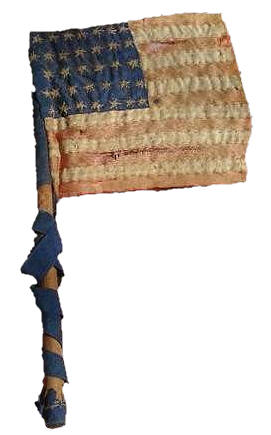
34 Stars,
Hand Embroidered Parade Flag |
Military Flags
Of the
military flags that have survived
from the period, many are very poor
condition. Their use in
battle, improper storage in state
institutions, souveniring, and the
fact that they were typically made
of weighted silk which deteriorated
rapidly, all contribute to a modern
race to save these flags from being
completely lost. Many states
are undertaking efforts to remove
their Civil War flags from the glass
cases and stands in their state
capitals, where many flags began
deteriorating under their own
weight, into flat storage drawers in
cases housed under
climate-controlled conditions.
Generally, official flags fall into
the following categories:
 |
Flank Markers.
These flags were used to
demarcate the left and right
limits of a particular
limit. The prominent
display of the unit
designator assisted with
orienting and maneuvering
the units on the field of
battle. This rare flank
marker of the 176th New York
State Veteran Volunteer
Infantry Regiment saw action
in numerous campaigns
including the defense of New
Orleans and the Shenandoah
Valley Campaign. (The
Rare Flags
Collection. Note: Click
here to see the
flank markers of the 175th
Regiment, sister unit to the
176th Regiment, in the New
York State Collection.)
|
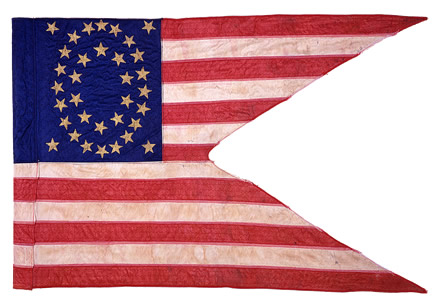 |
Guidons.
Guidons were typically
carried by mounted cavalry
units and artillery units.
Their smaller size and
swallowtail configuration
made them less resistant to
the wind while carrying the
flag on horseback.
(Battery A, 3rd Artillery,
NY Volunteers, New York
State Collection) |
 |
Camp Colors.
These smaller printed flags
were typically found within
a unit's camp, demarking the
location of the unit
commander or command post
within the camp. Their
style is very distinctive in
that they usually don't
have a white hoist, and
instead have a sleeve made
by extending the the canton
and stripes.
(The
Rare Flags
Collection.
Unknown New York Regiment,
Found in New York State.
Note: Click here to see
a pair
of Camp Colors for the 128th
NY Volunteer Infantry of
same design in the New York
State Collection.) |
Each regiment typically
carried three stands of
colors: Regimental
Colors, National Colors and
State Colors.
|
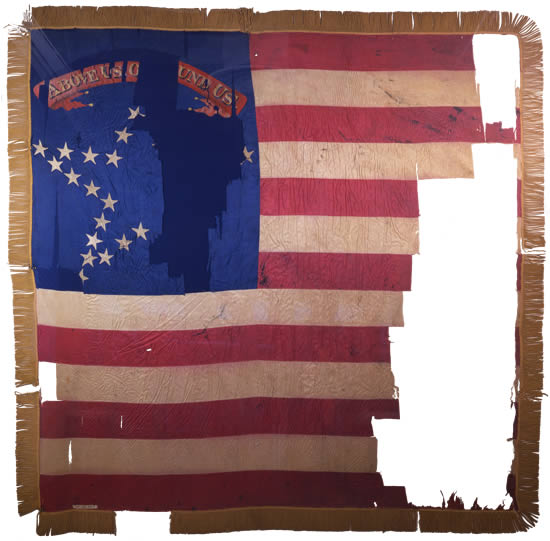 |
National Colors.
National Colors are the
Stars and Stripes, though
often with fanciful cantons
and varied star patterns.
Significant losses of fabric
to many Civil War battle
flags are common, and in
some cases virtually none of
the original flag remains.
(5th Regiment, NY Volunteer
Infantry, New York State
Collection) |
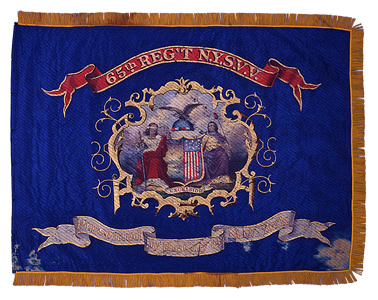 |
State Colors.
State Colors typically show
either the state seal or a
regional or local seal.
For some states, like
Pennsylvania, the state
colors show the state seal
in the canton of a U.S. flag
of red and white stripes.
(65th Regiment, NY
Volunteer Infantry, New York
State Collection) |
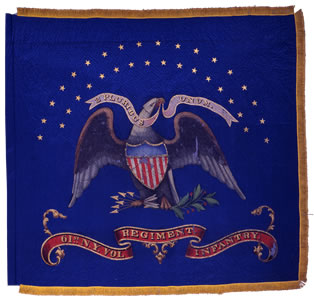 |
Regimental Colors.
Regimental Colors usually
feature a large American
eagle with an arc of stars
above and a ribbon
emblazoned with the unit
designation below. (61st
Regiment, NY Volunteer
Infantry, New York State
Collection)
|
Company grade units carried
their own colors.
Often times, these colors
were homemade "presentation
colors" presented to the
unit by the community where
the units mustered.
Other times, these were
official military grade
colors issued to the units
when they entered the
service. Many of these
company-grade colors have
been lost over time.
Unlike regimental colors
which were ceremoniously
returned to state capitals,
company colors were rarely
turned into the state and
were instead brought home
with the company units.
They often descend in the
families of the unit
commanders or color bearers.
Often they were unfurled at
reunion ceremonies, and many
were simply lost to time.
Military-grade company
colors are typically
elongated and rectangular, unlike their
regimental counterparts
which were typically nearly
square.
|
 |
Company Presentation Colors,
34 Stars.
Company A, 16th New York
Volunteer Infantry,
descended in the family of
company commander Captain
Isaac Merry.
Click here to read more
about this flag. |
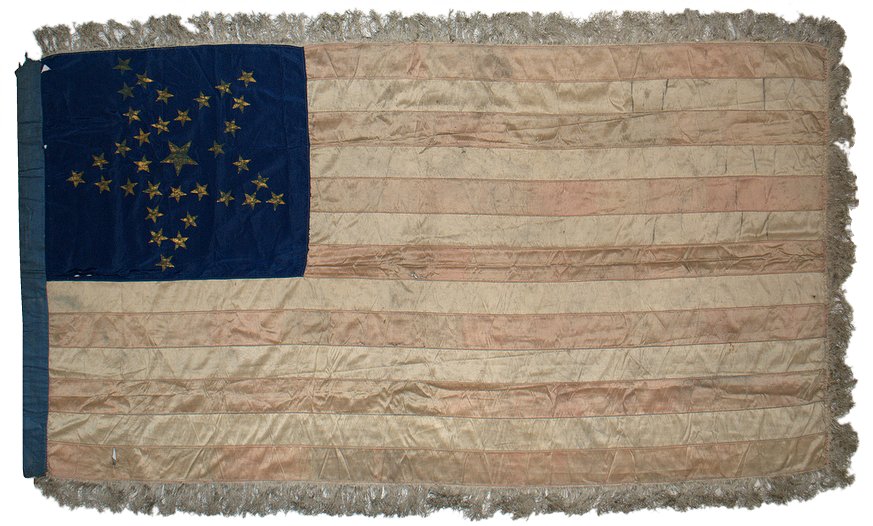 |
Military Grade Company
Colors, 34 Stars.
Company L, 102nd
Pennsylvania Volunteer
Infantry, descended in the
family of company commander
Captain John McFarland. |
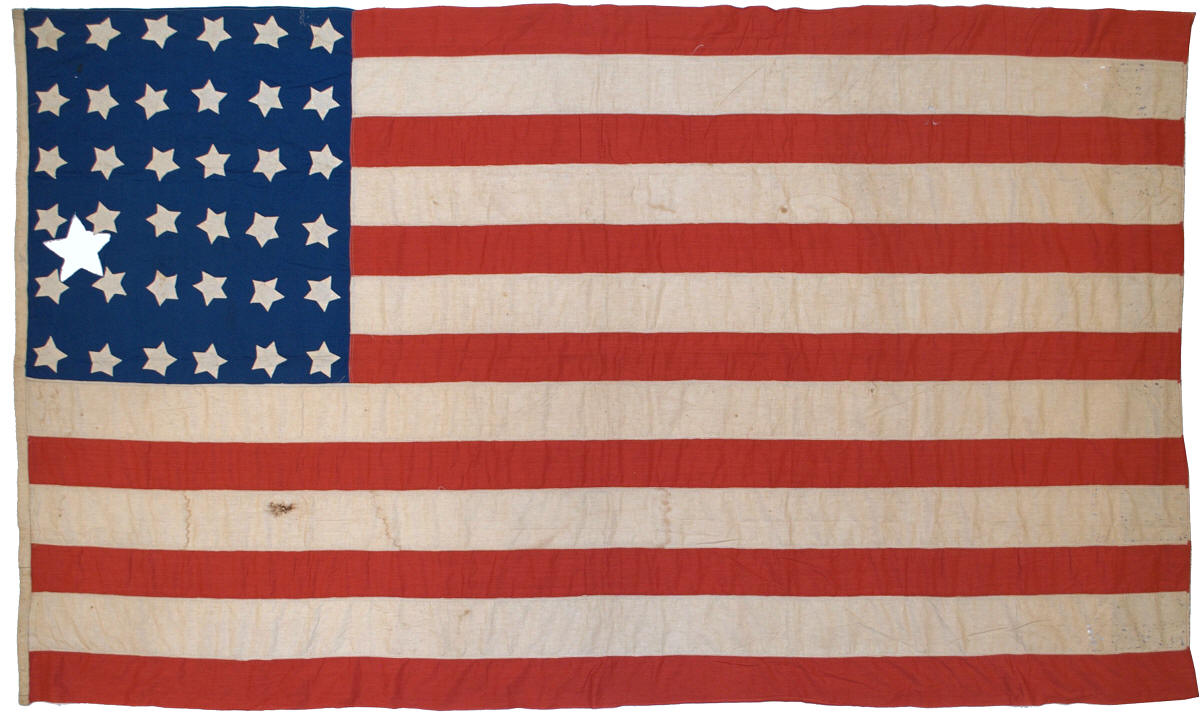 |
Possible Military Company
Replacement Colors, 36 Stars.
Unattributed unit, possibly
a late war period homemade
replacement company colors.
The tall, narrow canton and
long stripes are in the
style of a company-grade
union battle flag. The
souveniring of a star-shaped
portion of the canton is
strong evidence supporting
military use. |
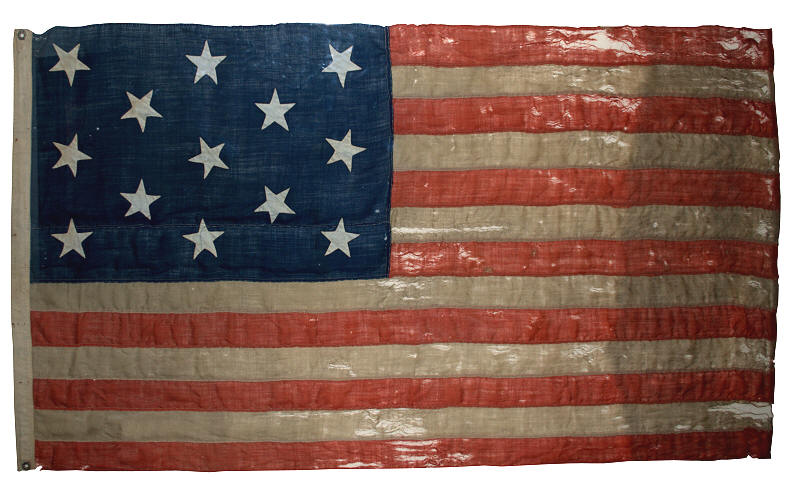 |
Civil War Naval Boat Ensign,
Official Size, 13 Stars.
This Naval Ensign from the
Civil War era is an official
6 foot as designated by the
Navy in the 1863 Naval
Regulations .Although its
specific history is
uncertain, a later period
hand written note
accompanying the flag
references the Battle of
Mobile Bay (August, 1864)
and quotes Admiral David G.
Farragut's memorable
(though most likely
glamorized) exclamation, "Damn the
torpedoes! Full speed
ahead!" |
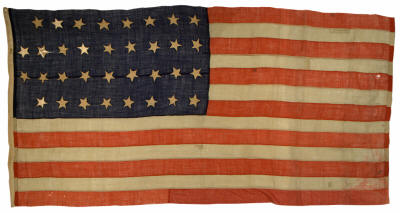 |
American National Flag, 34
Stars, Opening Years of the
Civil War.
This entirely hand sewn
34 star flag features an
elongated canton in a rare
8-9-9-8 pattern. Two
spaces remain in the upper
and lower left corners of
the canton for the addition
of new stars. The flag
descended in the family of
Sergeant Major Daniel F.
French, who returned with
the flag from Washington,
D.C. following the war. Daniel
French was a
member of Company E of the
56th Regiment Massachusetts
Volunteer Infantry.
|
Exclusionary Flags
Although President Lincoln urged
Americans to refrain from removing
stars from the flag in the face of
secession, cases exist where stars
were in fact removed from flags of
the period. Flags of the
period with less than official stars
leaves open speculation as to the
circumstances when the flag was
produced. With the
introduction of new states into the
Union such as Kansas and West
Virginia, the incremental secession
of southern states, and the presence
of territories which were either
pro-Union or pro-Confederacy
leaning, it's difficult to clearly
attribute the precise reasoning
behind flags of unusual star counts,
such as 23, 24, 25 and others.
Still, due to the ability to
reasonably date these flags based on
construction and materials, we do
know that they were produced.
Confederate Flags
The
flags of the Confederacy fall into
four major categories: the
First National Flag (also known as
the "Stars and Bars"), the Second
National Flag (also known as the
"Stainless Banner"), the Third
National Flag (also known as the
"Blood Stained Banner") and the
Battle Flag of the Confederacy,
commonly thought of today as the
Confederate flag.
|
|
|
|

